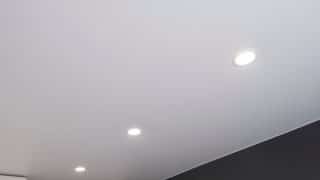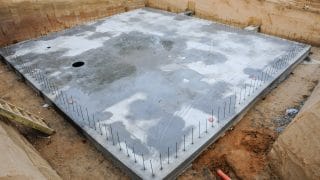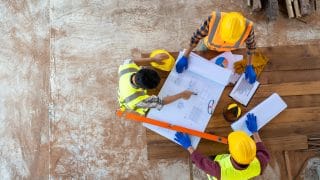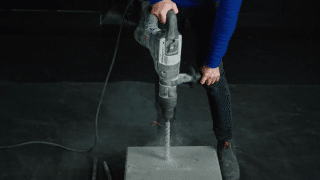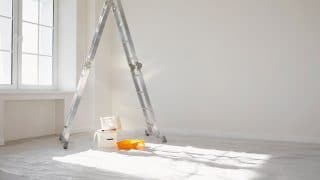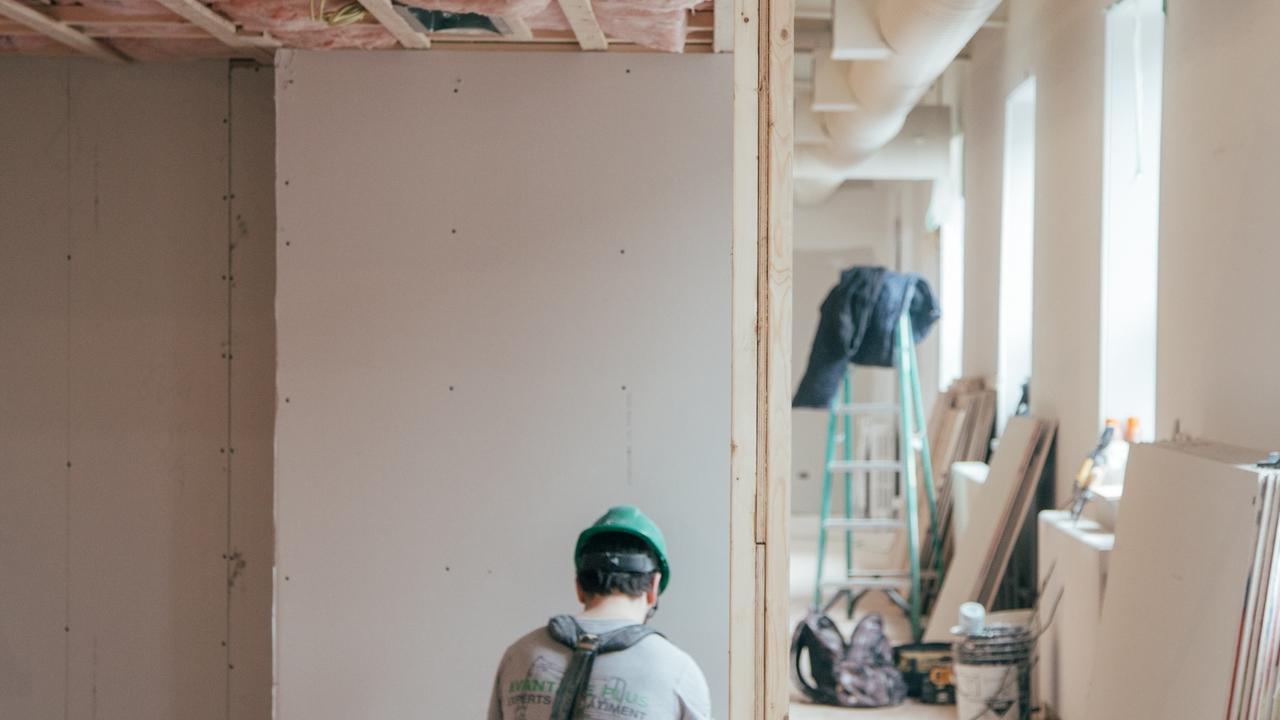
You may notice that home builders sometimes use “drywall” and “Sheetrock” interchangeably, or even as verbs—as in, “I’m going to Sheetrock this room”. In fact, Sheetrock® is a brand of drywall that is a registered trademark of the U.S. Gypsum Company, but there are no functional differences between drywall and Sheetrock®.
Since its invention over a hundred years ago, drywall has eased the process of building a house and embarking on home improvement projects. Before the advent of drywall, builders had to apply plaster in layers on supporting wooden strips called laths. Each coat necessitated ample drying time, and the plaster needed time to harden at the end of the process. Needless to say, lath and plaster was inefficient.
The prototype for drywall—a layer of plaster between four layers of wool felt—was first made in the late 19th century and was called Sackett Board, for its inventor, Augustine Sackett. The U.S. Gypsum Company began improving on the invention between 1910 and 1930, replacing plaster with gypsum plaster. Its new Sheetrock® brand came into use during World War II, giving builders a fast and relatively easy way to erect interior walls.
Regardless of which brand you choose, the technique for installing drywall is basically the same across brands. You’ll cut the sheet of drywall to size by scoring the paper and breaking the internal material. You’ll then fix them to wall studs or ceiling joists with a nail gun, drywall screws, or drywall fasteners. You’ll need to conceal the seams between boards, which you’ll do by covering them with tape and joint compound. To get a totally smooth wall, some builders seal it with veneer plaster.
What is drywall?
Drywall is simply a panel made of gypsum plaster covered with heavy paper. You’ll also see it labeled as wallboard, plasterboard, gypsum board, and of course, Sheetrock®. It comes in different panel thicknesses, from ¼ inch to ¾ inch.
Some drywall, called greenboard, is coated with an oil-based additive on its green paper to make it moisture resistant. Cement board is a more water resistant construction material than gypsum. Soundboard uses wood fibers to augment acoustics, while soundproof drywall has polymers that damp sound.
There are four main types of drywall:
- Standard drywall is the least expensive and comes in different sizes and thicknesses.
- Mold resistant drywall is covered in fiberglass instead of paper to resist mold and mildew.
- Moisture resistant drywall, the greenboard mentioned above, is a pricey but good choice for humid areas like bathrooms and laundry rooms.
- Fire resistant drywall is made with non-combustible fibers and is required by some building codes.
What is Sheetrock?
Sheetrock® is a trademarked brand of drywall, manufactured by USG – U.S. Gypsum Company. Because of its early appearance in the market and tremendous popularity, Sheetrock® has become synonymous with drywall, much like Kleenex has become the shorthand for tissues. Like other drywall, it comes in various thicknesses, and in mold- and moisture-resistant options. Sheetrock® comes in three grades of fire-resistant panels. It’s also considered lightweight and sag-resistant, so is a good option for ceilings.
Introduction to Drywall
You may notice that home builders sometimes use “drywall” and “Sheetrock” interchangeably, or even as verbs—as in, “I’m going to Sheetrock this room”. In fact, Sheetrock® is a brand of drywall that is a registered trademark of the U.S. Gypsum Company, but there are no functional differences between drywall and Sheetrock®.
Since its invention over a hundred years ago, drywall has eased the process of building a house and embarking on home improvement projects. Before the advent of drywall, builders had to apply plaster in layers on supporting wooden strips called laths. Each coat necessitated ample drying time, and the plaster needed time to harden at the end of the process. Needless to say, lath and plaster was inefficient.
The prototype for drywall—a layer of plaster between four layers of wool felt—was first made in the late 19th century and was called Sackett Board, for its inventor, Augustine Sackett. The U.S. Gypsum Company began improving on the invention between 1910 and 1930, replacing plaster with gypsum plaster. Its new Sheetrock® brand came into use during World War II, giving builders a fast and relatively easy way to erect interior walls.
Regardless of which brand you choose, the technique for installing drywall is basically the same across brands. You’ll cut the sheet of drywall to size by scoring the paper and breaking the internal material. You’ll then fix them to wall studs or ceiling joists with a nail gun, drywall screws, or drywall fasteners. You’ll need to conceal the seams between boards, which you’ll do by covering them with tape and joint compound. To get a totally smooth wall, some builders seal it with veneer plaster.
What is drywall?
Drywall is simply a panel made of gypsum plaster covered with heavy paper. You’ll also see it labeled as wallboard, plasterboard, gypsum board, and of course, Sheetrock®. It comes in different panel thicknesses, from ¼ inch to ¾ inch.
Some drywall, called greenboard, is coated with an oil-based additive on its green paper to make it moisture resistant. Cement board is a more water resistant construction material than gypsum. Soundboard uses wood fibers to augment acoustics, while soundproof drywall has polymers that damp sound.
There are four main types of drywall:
- Standard drywall is the least expensive and comes in different sizes and thicknesses.
- Mold resistant drywall is covered in fiberglass instead of paper to resist mold and mildew.
- Moisture resistant drywall, the greenboard mentioned above, is a pricey but good choice for humid areas like bathrooms and laundry rooms.
- Fire resistant drywall is made with non-combustible fibers and is required by some building codes.
What is Sheetrock?
Sheetrock® is a trademarked brand of drywall, manufactured by USG – U.S. Gypsum Company. Because of its early appearance in the market and tremendous popularity, Sheetrock® has become synonymous with drywall, much like Kleenex has become the shorthand for tissues. Like other drywall, it comes in various thicknesses, and in mold- and moisture-resistant options. Sheetrock® comes in three grades of fire-resistant panels. It’s also considered lightweight and sag-resistant, so is a good option for ceilings.
Choosing building materials is only one aspect of construction. Learn more about the building process in MT Copeland’s online classes, taught by professional builder and craftsman Jordan Smith.
What are the advantages and disadvantages of drywall?
Drywall and Sheetrock pros
- It’s less expensive than other methods.
- It’s easier to install than other methods.
- It’s faster to install than other methods. Drywall can take a day to install versus a week-long process of lath and plaster.
- Special materials offer extra functions, like fireproofing, moisture resistance, and mold resistance.
Drywall and Sheetrock cons
- It doesn’t block sound as well as plaster.
- Several people or a special lift may be needed to lift large drywall sheets.
- Drywall and Sheetrock® can be damaged more easily by water, and the paper that sandwiches the gypsum can mold.
- Using drywall does mean you’ll waste some material; workers waste a lot of it cutting panels to size.
Finally, if you decide on drywall for your construction project, look for products that don’t contain sulfur. Some drywall containing sulfur can emit bad odors, cause health problems, and corrode metal.
MT Copeland offers video-based online classes that give you a foundation in construction fundamentals with real-world applications. Classes include professionally produced videos taught by practicing craftspeople, and supplementary downloads like quizzes, blueprints, and other materials to help you master the skills.
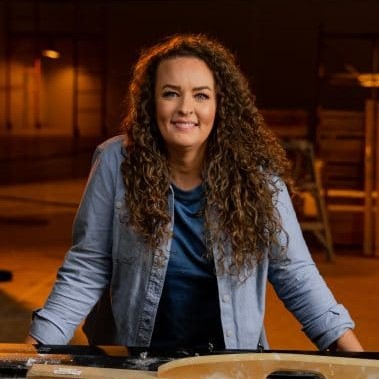
Featured Instructor
Lydia Crowder
Lydia Crowder is a second generation drywall finisher. She started helping out her dad with the family business as a kid and quickly grew to love it. Her dad instilled a love for quality, craftsmanship, and sharing knowledge. She has over 18 years of experience in the field and runs Trinity Drywall with her husband Ryan. Together they finish over 500,000 square feet of drywall board a year: that's an average of a house a week. Lydia started sharing drywall tips and tricks on Instagram under the name DrywallShorty and the response was explosive. There is a huge lack of basic knowledge in the industry and Lydia has become a go-to for professionals and DIY-ers alike.
Explore Classes
